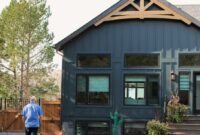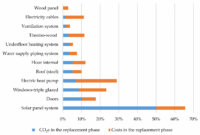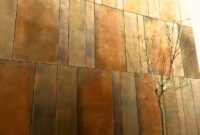Designing a swimming pool with a waterfall and spa features is more than just building a pool; it’s about crafting an oasis of relaxation and luxury. This guide explores the design process from conceptualization to completion, covering everything from waterfall styles and spa placement to plumbing, filtration, landscaping, and safety considerations. We’ll delve into the technical aspects, such as pump selection and filtration system choices, while also focusing on the aesthetic elements that will transform your backyard into a personal paradise.
Get ready to dive into the details and create your dream aquatic retreat.
The journey to building your perfect pool involves careful consideration of many factors. Choosing the right waterfall style – whether a dramatic sheer descent or a gentler cascading effect – will significantly impact the overall aesthetic. Integrating a spa seamlessly requires thoughtful placement, considering sun exposure, privacy, and convenient access. Plumbing and filtration are critical for maintaining water quality, and the surrounding landscape should complement the pool’s design.
Finally, safety and adherence to local building codes are paramount to ensure a worry-free enjoyment of your investment.
Waterfall Design Considerations
Creating a stunning and functional waterfall for your swimming pool involves careful consideration of several key aspects. The style, materials, and engineering principles all play crucial roles in determining the final aesthetic and operational success of the feature. Choosing the right combination will ensure a beautiful and long-lasting addition to your pool.
Waterfall Styles
Different waterfall styles offer unique visual impacts and require varying levels of engineering complexity. The best choice depends on the overall design of the pool, the available space, and your budget.
| Style | Visual Impact | Cost | Maintenance |
|---|---|---|---|
| Sheer Descent | Clean, modern; creates a dramatic, uninterrupted sheet of water. | Moderate to High (depending on height and materials) | Moderate; regular cleaning of the face to prevent mineral buildup. |
| Cascading | Natural, flowing; creates a more relaxed and organic feel. | Moderate | Moderate; occasional debris removal. |
| Tiered | Multi-layered; offers visual interest and can be adapted to various spaces. | High (due to increased complexity) | High; requires more frequent cleaning and potential adjustments to water flow between tiers. |
Waterfall Engineering Principles
Achieving a functional and aesthetically pleasing waterfall requires precise engineering. Proper water flow rate is paramount, ensuring sufficient volume without overwhelming the pump or causing erosion. This involves careful calculations based on the waterfall’s height, width, and desired flow rate. Pump selection is crucial; the pump must be powerful enough to overcome the head pressure (the vertical distance the water needs to be lifted) while maintaining a consistent flow.
The formula for calculating head pressure is:
Head Pressure (in feet) = Vertical Height (in feet) + Friction Loss (in feet)
Friction loss depends on the pipe length, diameter, and the number of bends. Accurate calculations are essential to prevent pump failure or insufficient water flow.
Waterfall Construction Materials
The choice of materials significantly impacts the waterfall’s durability, cost, and aesthetic appeal.Natural stone offers a timeless, organic look but can be expensive and require specialized installation. Concrete is a versatile and cost-effective option, allowing for customization of shape and texture. Artificial rock offers a realistic stone appearance at a lower cost than natural stone, but it may not be as durable in the long term.
Each material has its pros and cons; the best choice depends on the project’s budget and desired aesthetic. For example, a high-end project might utilize natural flagstone for a luxurious appearance, while a budget-conscious project might opt for durable, textured concrete.
Spa Integration and Placement
Integrating a spa into your waterfall pool design offers a luxurious and relaxing addition. Careful consideration of placement is key to maximizing enjoyment and minimizing potential drawbacks. Factors such as sun exposure, privacy, and ease of access should be carefully weighed to create a harmonious and functional design. The spa’s location will also influence the overall aesthetic appeal of the entire pool area.Optimal placement considers several key factors.
Proximity to the waterfall can create a visually stunning effect, but excessive splashing might require careful consideration of the spa’s construction and location. Similarly, positioning the spa in a sunny area allows for natural heating, but excessive sun exposure can make it uncomfortably hot. A shaded location, perhaps partially enclosed by landscaping, could provide more privacy and a cooler environment.
Finally, easy access from the pool and surrounding areas is crucial for convenience and safety. Ideally, the spa should be easily accessible without requiring extensive walking or navigating obstacles.
Spa Area Layout, Designing a swimming pool with a waterfall and spa features
A well-designed spa area enhances the overall relaxation and enjoyment. The following features contribute to a luxurious and functional space:
- Seating: Multiple seating options should be considered, such as built-in bench seating, loungers, or even underwater seating. The number of seats should align with the anticipated number of users.
- Jets: Strategic placement of hydrotherapy jets is crucial for targeting specific muscle groups. A variety of jet types and intensities can cater to individual preferences.
- Lighting: Subtle underwater lighting creates a relaxing ambiance, while adjustable lighting allows for mood setting. Consider fiber optic lighting for a sophisticated touch.
- Water Features: Small, cascading waterfalls or gentle bubblers can enhance the sensory experience and create a calming atmosphere. These should be designed to complement, not compete with, the main waterfall feature.
Spa Types and Suitability
Several spa types offer varying degrees of integration with a waterfall pool. Each type presents unique advantages and disadvantages regarding cost, size, and features.
| Spa Type | Cost | Size | Features | Suitability for Waterfall Pool Integration |
|---|---|---|---|---|
| In-ground | High | Variable, often large | Customizable features, seamless integration | Excellent, allows for creative design integration |
| Above-ground | Medium | Variable, generally smaller than in-ground | Pre-fabricated, easier installation | Good, requires careful planning for placement and aesthetics |
| Swim spa | High to Very High | Large, often includes a swimming area | Combination of spa and swimming pool features | Moderate, requires significant space and careful design integration |
Plumbing and Filtration Systems: Designing A Swimming Pool With A Waterfall And Spa Features
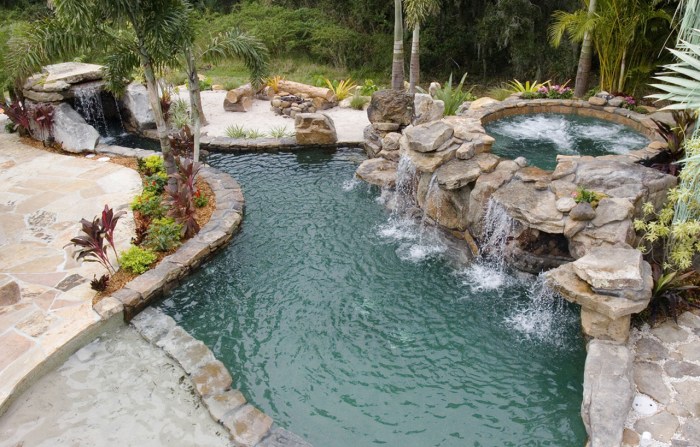
Source: lucaslagoons.com
Creating a functional and aesthetically pleasing pool with a waterfall and spa requires careful planning of the plumbing and filtration systems. These systems are crucial for ensuring the longevity of your investment, maintaining water quality, and providing a safe and enjoyable swimming experience. Proper design and installation will minimize maintenance and maximize efficiency.
Plumbing System Design
The plumbing system for a pool with a waterfall and spa is more complex than a standard pool. It needs to manage water flow between the pool, waterfall, and spa, while also accommodating features like jets and drains. A schematic diagram would illustrate the interconnectedness of these components. Imagine a central pump, labeled “Main Pump,” situated near the pool’s filter.
From this pump, a large diameter pipe (e.g., 6 inches) branches off to the waterfall. This pipe would gradually decrease in diameter as it approaches the waterfall feature, culminating in a series of smaller pipes feeding the individual waterfall cascades. Valves are strategically placed along this line to allow for easy isolation of sections for maintenance or repairs.
Another branch from the main pump, using a smaller diameter pipe (e.g., 4 inches), leads to the spa’s circulation pump. This pump then distributes water to the spa’s jets. Return lines from both the waterfall and the spa then feed back into the main pool’s filtration system. Multiple valves allow for independent control of the waterfall and spa, enabling you to operate them separately or simultaneously.
A dedicated drain line from the spa allows for efficient draining and cleaning. This entire system needs to be pressure-tested to ensure there are no leaks before the pool is filled.
Filtration and Sanitation Systems
Maintaining pristine water quality in a combined pool, waterfall, and spa system requires a robust filtration and sanitation system. The system must handle the combined water volume effectively and consistently remove debris and contaminants. Chlorine, bromine, or salt-water chlorination systems are common sanitation methods. Regular testing and adjustments are crucial to maintain proper chemical balance. The filtration system works in conjunction with the sanitation system to remove particulate matter.
Filtration Method Comparison
Several filtration methods exist, each with varying degrees of effectiveness and maintenance requirements. Sand filters are cost-effective and relatively low-maintenance, but their filtration efficiency is lower than other methods. Cartridge filters offer better filtration than sand filters, but require more frequent cleaning and replacement of cartridges. Diatomaceous earth (DE) filters provide the finest filtration, removing the smallest particles, but they require more maintenance and the disposal of used DE poses environmental concerns.
The choice of filtration method depends on factors such as budget, desired water clarity, and the frequency of cleaning one is willing to undertake. For a larger system combining a pool, waterfall, and spa, a DE filter might be preferred for superior water clarity, despite the increased maintenance. However, a larger sand filter could also suffice, depending on the overall water volume and desired level of filtration.
Consider the combined volume of the pool, waterfall basin, and spa when determining the appropriate filter size. For example, a system with a 20,000-gallon pool, a 500-gallon waterfall basin, and a 500-gallon spa would need a filter sized to handle at least 21,000 gallons.
Surrounding Landscape and Design
Creating a beautiful and functional landscape around your new pool, waterfall, and spa is crucial to maximizing enjoyment and enhancing the overall aesthetic appeal. The surrounding area should seamlessly integrate with the water features, creating a cohesive and inviting outdoor space. Careful consideration of plant choices, lighting, and hardscaping materials will contribute to a luxurious and relaxing atmosphere.The landscaping plan should prioritize both visual appeal and practicality.
Consider the flow of movement around the pool area, ensuring easy access to the spa and comfortable seating areas for relaxation. The chosen plants should complement the overall design and require minimal maintenance. Thoughtful lighting will dramatically impact the ambiance, transforming the space from day to night.
Plant Suggestions and Requirements
Selecting appropriate plants is vital for creating a thriving and visually appealing landscape. Consider factors such as sun exposure, water tolerance, and overall size to ensure the plants flourish and complement the pool area. Choosing drought-tolerant species can reduce water consumption and maintenance.
- Bamboo (various species): Provides a tropical feel, prefers full sun to partial shade, and tolerates moderate watering. Different varieties offer varying heights and densities, allowing for design flexibility.
- Palm Trees (various species): Create a lush, tropical atmosphere. Sun requirements vary depending on the species, but generally prefer full sun. Watering needs are moderate to high, depending on the climate and species.
- Creeping Fig (Ficus pumila): A versatile ground cover that thrives in both sun and shade. It requires moderate watering and can be trained to climb walls or fences, adding a touch of greenery to vertical surfaces.
- Oleander (Nerium oleander): A drought-tolerant shrub that tolerates full sun and requires minimal watering once established. It produces beautiful flowers, adding color to the landscape. Note: Oleander is toxic, so consider placement carefully if children or pets are present.
Lighting Design
Strategic lighting can dramatically enhance the ambiance of the pool area at night, creating a relaxing and inviting atmosphere. A variety of lighting types can be used to highlight different features and create different moods.Different lighting options offer distinct advantages. Submersible pool lights can illuminate the water, highlighting the waterfall and pool features. Pathway lighting ensures safe navigation around the area.
Landscape spotlights can highlight specific plants or architectural features. String lights can create a more casual and festive atmosphere. Consider using low-voltage lighting for safety and energy efficiency. Dimmers allow for adjustable brightness, creating a customizable ambiance.
Materials List for Surrounding Area
The choice of materials for paving, decking, and other hardscaping elements will significantly impact the overall aesthetic and durability of the pool area. Consider factors such as maintenance, cost, and the overall design style.
| Material | Quantity | Cost (Estimate) |
|---|---|---|
| Pavers (concrete or natural stone) | 100 sq ft | $1500 – $3000 |
| Decking (composite or wood) | 50 sq ft | $1000 – $2500 |
| Retaining Wall Blocks (concrete or natural stone) | 50 linear ft | $1000 – $2000 |
| Gravel | 1 cubic yard | $100 – $200 |
Safety and Regulations
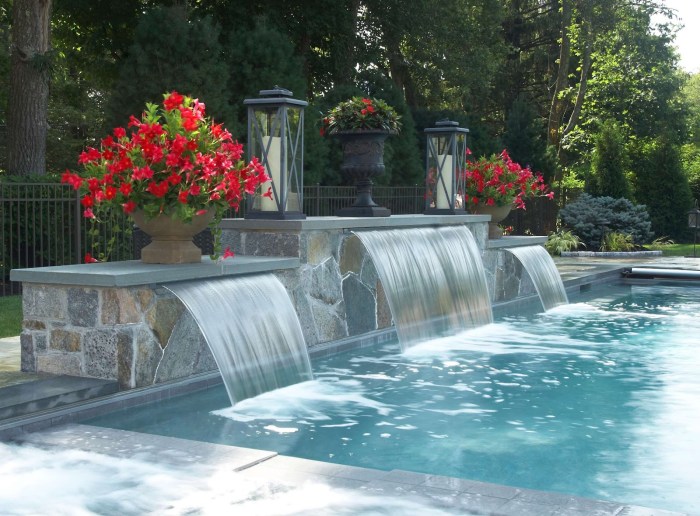
Source: googleusercontent.com
Designing a pool with a waterfall and spa requires careful consideration of safety to prevent accidents and ensure compliance with regulations. Ignoring safety measures can lead to serious injuries or legal issues. This section Artikels potential hazards and mitigation strategies, along with relevant building codes and regulations, and safe access point design.
Potential Safety Hazards and Mitigation
Waterfalls and spas, while aesthetically pleasing, introduce unique safety concerns. The forceful flow of water from a waterfall can pose a risk of injury, particularly to children. Spa jets, if improperly designed or used, can also cause injury. Slippery surfaces around the pool and spa are a common cause of falls. Inadequate lighting can increase the risk of accidents at night.To mitigate these risks, several measures should be implemented.
A sturdy fence, at least four feet high, surrounding the entire pool area is essential, especially if children will be using the pool. Non-slip surfaces should be used around the pool deck, spa, and waterfall area. These surfaces can include textured concrete, anti-slip tiles, or specialized pool decking materials. Adequate lighting, including underwater lights and pathway lighting, is crucial for nighttime visibility.
Clearly marked depth indicators are also important for users to understand the water depth in different areas. Regular maintenance of the pool and spa equipment is essential to prevent malfunction and reduce the risk of accidents. Finally, providing clear and visible safety instructions and rules is crucial.
Local Building Codes and Regulations
Building codes and regulations related to pool construction and safety vary by location. It’s crucial to consult with your local authorities and obtain the necessary permits before starting construction. For example, many jurisdictions mandate specific fence heights and types, require safety features like self-closing and self-latching gates, and have regulations on the minimum distance between the pool and property lines.
Some areas may also have regulations regarding the type of materials used for the pool structure, the depth of the pool, and the installation of safety equipment such as alarms or drain covers that meet specific standards to prevent entrapment. Failure to comply with these regulations can result in fines, delays in construction, or even the demolition of the pool.
Always check with your local building department for the most up-to-date and specific requirements for your area. For instance, in California, the Uniform Building Code dictates strict standards for pool fencing and safety features.
Safe Access Point Design
Designing safe access points to and from the pool and spa is crucial. Steps leading into and out of the pool should be wide, stable, and non-slip. Handrails should be provided on both sides of the steps for added safety. The steps should be designed to minimize the risk of tripping or slipping, perhaps with textured surfaces or anti-slip treads.
For spa access, a similarly designed, stable entry point should be created, considering the potential for users to enter and exit while wet. Ramps can be incorporated for accessibility, but should also incorporate non-slip materials and sufficient handrails. The entire access area should be well-lit and free of obstructions to prevent accidents. In addition, the area surrounding the access points should be designed to allow for easy movement and prevent overcrowding.
A well-designed access point contributes significantly to the overall safety of the pool and spa area.
Concluding Remarks
Creating a swimming pool with a waterfall and spa is a rewarding endeavor, transforming a simple backyard into a luxurious retreat. By carefully considering the design elements—from the type of waterfall and spa integration to the surrounding landscape and safety features—you can build a space that reflects your personal style and provides years of enjoyment. Remember, thorough planning and attention to detail are key to a successful project, resulting in a stunning and functional aquatic oasis that becomes the heart of your home.
Detailed FAQs
What are the ongoing maintenance costs for a pool with a waterfall and spa?
Ongoing costs include regular cleaning, chemical balancing, pump maintenance, and potential repairs to the waterfall or spa features. The exact cost will vary based on the size and complexity of the system.
How long does it typically take to build a pool with a waterfall and spa?
Construction time varies greatly depending on project size, complexity, and weather conditions, but it can range from several months to over a year.
What permits are typically required for building a pool with a waterfall and spa?
Permits vary by location, but generally include building permits, plumbing permits, and possibly electrical permits. Check with your local authorities for specific requirements.
Can I add a waterfall and spa to an existing pool?
Yes, it’s often possible to retrofit a waterfall and spa onto an existing pool, but this may require significant modifications and professional assessment to ensure structural integrity and compatibility with existing plumbing.
What is the best material for a pool waterfall?
The best material depends on budget and aesthetic preferences. Natural stone offers a luxurious look but can be expensive, while concrete is more affordable and versatile. Artificial rock provides a cost-effective alternative with a natural appearance.

